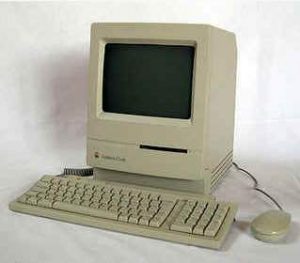Apple Macintosh Classic computer family
Apple Computer Inc. launched the Classic model (Cl1. image) in 1990, significantly cheaper than previous models, but with a reduced feature set. Its improved version, the Classic II (Cl2), was released in 1991, with an unchanged appearance, but with a more modern component base and a much higher price.
Use
It was specifically intended for office work (word processing, spreadsheets).
It was less suitable for graphics work due to its slower processor and display.
It was mostly used by businesses and occasionally schools.
Structure
Central unit
Word-organized machines: 16 bpW
- control unit:
- Cl1: Motorola 68000microprocessor
- clock speed: 8 MHz
- 16-bit bus system
- Cl2: Motorola 68030 microprocessor
- clock speed: 16 MHz
- 32-bit bus system
- Cl1: Motorola 68000microprocessor
- main store:
- RAM:
- Cl1: 1 MB (max. 4 MB) RAM,
- Cl2: 2 MB (max. 10 MB) RAM, cycle time 120 ns; expandable with 30-pin SIMM cards
- ROM: 512 KB
- RAM:
- calculator: ALU built into a microprocessor
Periphery
- backup:
- 1.44 MB floppy disk (SuperDrive, DB-19)
- Cl1: 40 MB hard drive (optional)
- Cl2: 40/80 MB hard drive ( SCSI )
- external devices:
- 23 cm (9″) monochrome CRT display
- keyboard (81 keys)
- one-button mouse
- connectors:
Operation
Instruction address range: 24 -32 bits
Screen resolution 512*342 pixels; refresh rate 43-63 Hz
8-bit audio output, 22 kHz
Power supply: 3.6V/76W (lithium battery)
Program set
- operating system: MAC OS 6.07, gradually upgraded to System 7.55
- programming languages:
- BASIC
- Pascal
Historical curiosities
The Macintosh Classic was essentially a further development of the Macintosh SE and Macintosh Plus, with faster processing speeds (5% and 25%, respectively).
However, in order to keep costs low, the feature set was reduced and the component set was no longer up-to-date.
Created: 2016.06.12. 22:57
Last modified: 2025.02.27. 17:37

